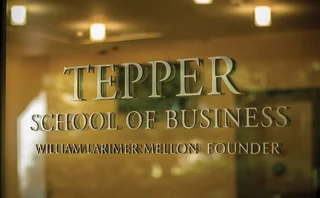
Quant Guide 2017: Carnegie Mellon University
Tepper School of Business, Pittsburgh, USA

MSc in Computational Finance | metrics table at end of article
Established in 1994, Carnegie Mellon’s computational finance master’s programme is one of the oldest postgraduate degrees of its kind. It benefits from the depth of expertise and experience of four of the university’s departments: maths, statistics, finance and IT.
Steve Shreve, one of the founders of the programme who has been at Carnegie since 1980, says of its origins: “There was expertise and the desire to do something collaborative and there was a perceived need: the banks were not being well served by the MBA students, they needed people with a more quantitative background. There was a member of our faculty in the business school who had developed a computer trading laboratory. It was underutilised, so he wanted to see more use of it.”
The intake of the programme has increased steadily over time, from just 14 in 1994 to between 90 and 100 now. The programme retains some core components that were in place in 1994, but since 2008 it has undergone significant changes.
Basic stochastic calculus, computer programming and data science are still there, along with modules on statistical inference, finance and microeconomics courses, as well as newer additions on market microstructure, algorithmic trading and machine learning. Programme administrators hold annual meetings with an advisory board of practitioners to discuss the needs of the financial industry, and identify how the programme can best address them.
The structure of the programme allows for flexibility, says Shreve: “We can shift emphasis within our four departments depending on what the industry is doing. Mathematical modelling used to be a larger part of the programme; it’s still a core part, but we’ve scaled it back and turned that space over to the statistics department. They’ve developed materials on machine learning and data analytics.”
Some of the modules are taught by academics in tandem with practitioners. Shreve teaches a course with Leif Anderson, the global co-head of the quantitative strategies group at Bank of America Merrill Lynch, for instance.

Dedicated placement officers help students secure internships, but they can also draw on the support of an alumni network to help them climb on to the career ladder.
Talis Bauer graduated from this programme in 2006. He currently works for JP Morgan as an investment strategist. According to Bauer, the strong applied angle of the programme was one of the reasons he chose it over rival offerings after completing his bachelor’s degree at Carnegie Mellon.
“I found some of the other programmes a bit more theoretical. I liked the fact that it was a standalone degree in quantitative finance.”
Bauer found the timeframe of the programme, which runs for three semesters, advantageous when it came to getting an internship.
“The programme is lined up with the investment bank recruiting season, and that’s where I was targeting to get a job. It was good to have that first semester under your belt, and then start the interview process. In the first semester we had some of the practical bond math classes, basic options and they actually came in handy during the interview.”
Students can gain additional practical experience by taking part in domestic and international competitions. Carnegie Mellon hosts an in-house trading competition sponsored by Deutsche Bank, and students regularly go to the Rotman International Trading Competition in Toronto.

Click here for links to the other universities and an explanation of how to read the metrics tables
Only users who have a paid subscription or are part of a corporate subscription are able to print or copy content.
To access these options, along with all other subscription benefits, please contact info@risk.net or view our subscription options here: http://subscriptions.risk.net/subscribe
You are currently unable to print this content. Please contact info@risk.net to find out more.
You are currently unable to copy this content. Please contact info@risk.net to find out more.
Copyright Infopro Digital Limited. All rights reserved.
As outlined in our terms and conditions, https://www.infopro-digital.com/terms-and-conditions/subscriptions/ (point 2.4), printing is limited to a single copy.
If you would like to purchase additional rights please email info@risk.net
Copyright Infopro Digital Limited. All rights reserved.
You may share this content using our article tools. As outlined in our terms and conditions, https://www.infopro-digital.com/terms-and-conditions/subscriptions/ (clause 2.4), an Authorised User may only make one copy of the materials for their own personal use. You must also comply with the restrictions in clause 2.5.
If you would like to purchase additional rights please email info@risk.net
More on Quantitative finance
Quant Finance Master’s Guide 2025
Risk.net’s guide to the world’s leading quant master’s programmes, with the top 25 schools ranked
Baruch maintains top spot in 2025 Quant Master’s Guide
Sorbonne reclaims top spot among European schools, even as US salaries decouple
Quant Finance Master’s Guide 2023
Risk.net’s guide to the world’s leading quant master’s programmes, with the top 25 schools ranked
Baruch topples Princeton in Risk.net’s quant master’s rankings
US schools cement top five dominance as graduate salaries soar
Is it worth doing a quant master’s degree?
UBS’s Gordon Lee – veteran quant and grad student supervisor – asks the hard question
Starting salaries jump for top quant grads
Quant Guide 2022: Goldman’s move to pay postgrads more is pushing up incomes, says programme director
Quant Finance Master’s Guide 2022
Risk.net’s guide to the world’s leading quant master’s programmes, with the top 25 schools ranked
Princeton, Baruch and Berkeley top for quant master’s degrees
Eight of 10 leading schools for quantitative finance programmes are based in US, latest rankings show







